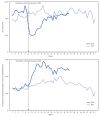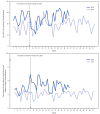Trends in U.S. Emergency Department Visits Related to Suspected or Confirmed Child Abuse and Neglect Among Children and Adolescents Aged <18 Years Before and During the COVID-19 Pandemic - United States, January 2019-September 2020
- PMID: 33301436
- PMCID: PMC7737689
- DOI: 10.15585/mmwr.mm6949a1
Trends in U.S. Emergency Department Visits Related to Suspected or Confirmed Child Abuse and Neglect Among Children and Adolescents Aged <18 Years Before and During the COVID-19 Pandemic - United States, January 2019-September 2020
Erratum in
-
Erratum: Vol. 69, No. 49.MMWR Morb Mortal Wkly Rep. 2021 Jan 15;70(2):63. doi: 10.15585/mmwr.mm7002a4. MMWR Morb Mortal Wkly Rep. 2021. PMID: 33444300 Free PMC article. No abstract available.
Abstract
Heightened stress, school closures, loss of income, and social isolation resulting from the coronavirus disease 2019 (COVID-19) pandemic have increased the risk for child abuse and neglect (1). Using National Syndromic Surveillance Program (NSSP) data from January 6, 2019-September 6, 2020, CDC tabulated weekly numbers of emergency department (ED) visits related to child abuse and neglect and calculated the proportions of such visits per 100,000 ED visits, as well as the percentage of suspected or confirmed ED visits related to child abuse and neglect ending in hospitalization, overall and stratified by age group (0-4, 5-11, and 12-17 years). The total number of ED visits related to child abuse and neglect began decreasing below the corresponding 2019 period during week 11 (March 15-March 22, 2020) for all age groups examined, coinciding with the declaration of a national emergency on March 13 (2); simultaneously, the proportion of these visits per 100,000 ED visits began increasing above the 2019 baseline for all age groups. Despite decreases in the weekly number of ED visits related to child abuse and neglect, the weekly number of these visits resulting in hospitalization remained stable in 2020; however, the yearly percentage of ED visits related to child abuse and neglect resulting in hospitalization increased significantly among all age groups. Although the increased proportion of ED visits related to child abuse and neglect might be associated with a decrease in the overall number of ED visits, these findings also suggest that health care-seeking patterns have shifted during the pandemic. Hospitalizations for child abuse and neglect did not decrease in 2020, suggesting that injury severity did not decrease during the pandemic, despite decreased ED visits. Child abuse is preventable; implementation of strategies including strengthening household economic supports and creating family-friendly work policies can reduce stress during difficult times and increase children's opportunities to thrive in safe, stable, and nurturing relationships and environments (3).
Conflict of interest statement
All authors have completed and submitted the International Committee of Medical Journal Editors form for disclosure of potential conflicts of interest. No potential conflicts of interest were disclosed.
Figures


Similar articles
-
Mental Health-Related Emergency Department Visits Among Children Aged <18 Years During the COVID-19 Pandemic - United States, January 1-October 17, 2020.MMWR Morb Mortal Wkly Rep. 2020 Nov 13;69(45):1675-1680. doi: 10.15585/mmwr.mm6945a3. MMWR Morb Mortal Wkly Rep. 2020. PMID: 33180751 Free PMC article.
-
Pediatric emergency department visits due to child abuse and neglect following COVID-19 public health emergency declaration in the Southeastern United States.BMC Pediatr. 2021 Sep 13;21(1):401. doi: 10.1186/s12887-021-02870-2. BMC Pediatr. 2021. PMID: 34517864 Free PMC article.
-
Emergency Department Visits for Suspected Suicide Attempts Among Persons Aged 12-25 Years Before and During the COVID-19 Pandemic - United States, January 2019-May 2021.MMWR Morb Mortal Wkly Rep. 2021 Jun 18;70(24):888-894. doi: 10.15585/mmwr.mm7024e1. MMWR Morb Mortal Wkly Rep. 2021. PMID: 34138833 Free PMC article.
-
How emergency department visits for substance use disorders have evolved during the early COVID-19 pandemic.J Subst Abuse Treat. 2021 Oct;129:108391. doi: 10.1016/j.jsat.2021.108391. Epub 2021 Apr 9. J Subst Abuse Treat. 2021. PMID: 33994360 Free PMC article. Review.
-
Epidemiology of Injuries to Early Adolescents from Family Violence Evaluated in an Urban Pediatric Emergency Department.Pediatr Emerg Care. 2023 Mar 1;39(3):113-119. doi: 10.1097/PEC.0000000000002891. Epub 2022 Dec 28. Pediatr Emerg Care. 2023. PMID: 36728739 Review.
Cited by
-
A comparison of child abuse and neglect encounters before and after school closings due to SARS-Cov-2.Child Abuse Negl. 2021 Aug;118:105132. doi: 10.1016/j.chiabu.2021.105132. Epub 2021 May 24. Child Abuse Negl. 2021. PMID: 34082194 Free PMC article.
-
Child Abuse Consultation Rates Before vs During the COVID-19 Pandemic in Japan.JAMA Netw Open. 2023 Mar 1;6(3):e231878. doi: 10.1001/jamanetworkopen.2023.1878. JAMA Netw Open. 2023. PMID: 36892844 Free PMC article.
-
Emergency Department Child Abuse Evaluations During COVID-19: A Multicenter Study.Pediatrics. 2022 Jul 1;150(1):e2022056284. doi: 10.1542/peds.2022-056284. Pediatrics. 2022. PMID: 35707943 Free PMC article.
-
Mental health & maltreatment risk of children with special educational needs during COVID-19.Child Abuse Negl. 2022 Aug;130(Pt 1):105457. doi: 10.1016/j.chiabu.2021.105457. Epub 2022 Jan 10. Child Abuse Negl. 2022. PMID: 35033372 Free PMC article.
-
The CDC's Adolescent Behaviors and Experiences Survey - Using Intersectionality and School Connectedness to Understand Health Disparities During the COVID-19 Pandemic.J Adolesc Health. 2022 May;70(5):703-705. doi: 10.1016/j.jadohealth.2022.02.001. Epub 2022 Feb 17. J Adolesc Health. 2022. PMID: 35461653 Free PMC article. No abstract available.
References
-
- World Health Organization. Global status report on preventing violence against children 2020. Geneva, Switzerland: World Health Organization; 2020. https://www.who.int/publications/i/item/9789240004191
-
- Office of the Federal Register. Declaring a national emergency concerning the novel coronavirus disease (COVID-19) outbreak: proclamation 9994 of March 13, 2020. Washington, DC: Office of the Federal Register; 2020. https://www.federalregister.gov/documents/2020/03/18/2020-05794/declarin...
-
- Fortson B, Klevens J, Merrick M, Gilbert L, Alexander S. Preventing child abuse and neglect: a technical package for policy, norm, and programmatic activities. Atlanta, GA: US Department of Health and Human Services, CDC; 2016. https://www.cdc.gov/violenceprevention/pdf/can-prevention-technical-pack...
-
- Peterman A, Potts A, O’Donnell M, et al. Pandemics and violence against women and children. Washington, DC: Centre for Global Development; 2020. https://www.cgdev.org/publication/pandemics-and-violence-against-women-a...
MeSH terms
LinkOut - more resources
Full Text Sources
Medical

